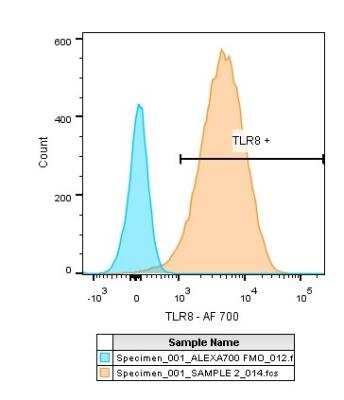TLR8 Antibody (44C143) [Alexa Fluor® 700]
Novus Biologicals, part of Bio-Techne | Catalog # NBP2-24917AF700


Key Product Details
Species Reactivity
Applications
Label
Antibody Source
Concentration
Product Specifications
Immunogen
Clonality
Host
Isotype
Scientific Data Images for TLR8 Antibody (44C143) [Alexa Fluor® 700]
Applications for TLR8 Antibody (44C143) [Alexa Fluor® 700]
CyTOF-ready
Dot Blot
Flow (Cell Surface)
Flow (Intracellular)
Flow Cytometry
Immunocytochemistry/ Immunofluorescence
Immunohistochemistry
Immunohistochemistry-Paraffin
Simple Western
Western Blot
Reviewed Applications
Read 1 review rated 4 using NBP2-24917AF700 in the following applications:
Formulation, Preparation, and Storage
Purification
Formulation
Preservative
Concentration
Shipping
Stability & Storage
Background: TLR8
TLR8 is highly similar to TLR7 and both pathways are mediated by the adapter protein MyD88 to signal through IFN regulatory factor 7 (IRF7) and nuclear factor (NF)-kappaB (1-3,5). However, TLR7 recognizes guanosine and GU-rich ssRNA, while TLR8 recognizes uridine and AU-rich sequences (2,5). TLR7/TLR8 agonists, including derivatives of the immunostimulatory imiquimod, have been shown to be a promising cancer therapy capable of providing anticancer signals to antigen presenting cells (APCs), with many agonists being tested in both pre-clinical and clinical trials (6). Similarly, studies suggest that agonists for TLR8, in combination with other individual TLR agonists and antagonists, may also be useful for treating inflammatory allergic diseases, such as allergic rhinitis (7).
References
1. Sakaniwa, K., & Shimizu, T. (2020). Targeting the innate immune receptor TLR8 using small-molecule agents. Acta crystallographica. Section D, Structural biology, 76(Pt 7). https://doi.org/10.1107/S2059798320006518
2. Cervantes, J. L., Weinerman, B., Basole, C., & Salazar, J. C. (2012). TLR8: the forgotten relative revindicated. Cellular & molecular immunology. https://doi.org/10.1038/cmi.2012.38
3. Ohto, U., Tanji, H., & Shimizu, T. (2014). Structure and function of toll-like receptor 8. Microbes and infection. https://doi.org/10.1016/j.micinf.2014.01.007
4. Uniprot (Q9NR97)
5. Jannuzzi, G. P., de Almeida, J., Paulo, L., de Almeida, S. R., & Ferreira, K. S. (2020). Intracellular PRRs Activation in Targeting the Immune Response Against Fungal Infections. Frontiers in cellular and infection microbiology. https://doi.org/10.3389/fcimb.2020.591970
6. Frega, G., Wu, Q., Le Naour, J., Vacchelli, E., Galluzzi, L., Kroemer, G., & Kepp, O. (2020). Trial Watch: experimental TLR7/TLR8 agonists for oncological indications. Oncoimmunology. https://doi.org/10.1080/2162402X.2020.1796002
7. Golshiri-Isfahani, A., Amizadeh, M., & Arababadi, M. K. (2018). The roles of toll like receptor 3, 7 and 8 in allergic rhinitis pathogenesis. Allergologia et immunopathologia. https://doi.org/10.1016/j.aller.2017.09.026
Long Name
Alternate Names
Gene Symbol
Additional TLR8 Products
Product Documents for TLR8 Antibody (44C143) [Alexa Fluor® 700]
Product Specific Notices for TLR8 Antibody (44C143) [Alexa Fluor® 700]
Alexa Fluor (R) products are provided under an intellectual property license from Life Technologies Corporation. The purchase of this product conveys to the buyer the non-transferable right to use the purchased product and components of the product only in research conducted by the buyer (whether the buyer is an academic or for-profit entity). The sale of this product is expressly conditioned on the buyer not using the product or its components, or any materials made using the product or its components, in any activity to generate revenue, which may include, but is not limited to use of the product or its components: (i) in manufacturing; (ii) to provide a service, information, or data in return for payment; (iii) for therapeutic, diagnostic or prophylactic purposes; or (iv) for resale, regardless of whether they are resold for use in research. For information on purchasing a license to this product for purposes other than as described above, contact Life Technologies Corporation, 5791 Van Allen Way, Carlsbad, CA 92008 USA or outlicensing@lifetech.com. This conjugate is made on demand. Actual recovery may vary from the stated volume of this product. The volume will be greater than or equal to the unit size stated on the datasheet.
This product is for research use only and is not approved for use in humans or in clinical diagnosis. Primary Antibodies are guaranteed for 1 year from date of receipt.